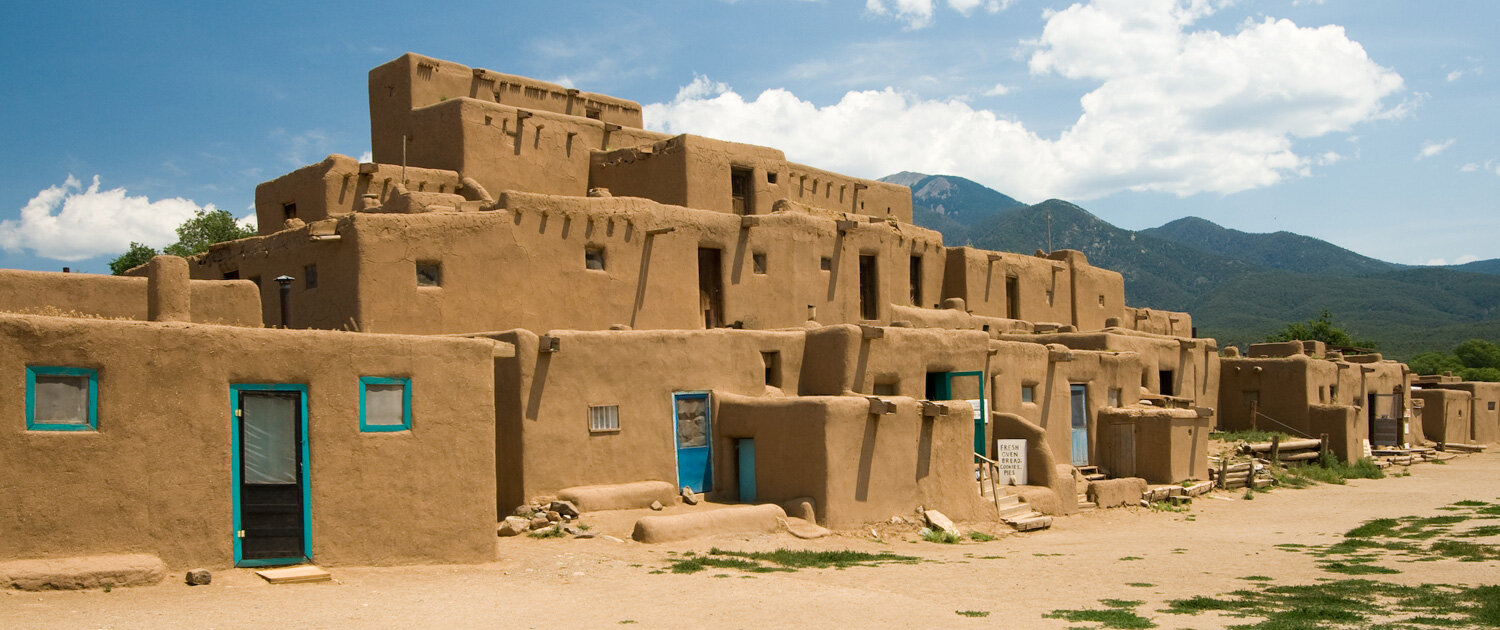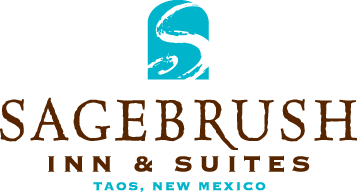
Explore Taos Pueblo
So Much to See, So Little Time
Historic Landmarks & Museums
Drawing visitors from all over the world with its dramatic desert landscapes and its historic Pueblo culture, Taos offers dozens of attractions and activities. Whether it's a fine art museum, a round of demanding golf, or hiking in the Sangre de Cristo Mountains, your journey to our northern New Mexican town will be one to remember.
Important Tip
Taos has an elevation of 6,967 feet (more than 1,200 feet higher than Denver, the "Mile High City"). While visiting, please remember to drink plenty of water and use sunscreen, as there is less protection from the sun at this elevation.
Taos Pueblo
120 Veterans Highway • Taos, NM 87571 • 575.758.1028
The Taos Pueblo is an ancient pueblo belonging to a Tiwa-speaking Native American tribe of Puebloan people. Ancient ruins in the Taos Valley indicate that the Native Americans lived here nearly 1,000 years ago, with the main part of the present buildings likely constructed between 1000 and 1450 AD. The Pueblo is made entirely of adobe (earth mixed with water and straw) then either poured into forms or made into sun-dried bricks. Traditions dictate that no electricity or running water be allowed within the Pueblo walls. Approximately 150 people live within the Taos Pueblo full-time. The Taos Pueblo is generally open to visitors daily, except when tribal rituals require closing the Pueblo. Regular hours are Monday - Saturday from 8:00 AM - 4:30 PM and Sunday from 8:30 AM - 4:30 PM. Please contact Taos Pueblo Tourism for closure information. Guided tours are offered year round. The tour is optional, but is very memorable and highly recommended.
The Pueblo also operates Taos Mountain Casino.
San Francisco de Asís Mission Church
60 St Francis Plaza • Ranchos de Taos, NM 87557 • 575.758.2754
A National Historic Landmark and United Nations World Heritage Site, the Spanish Colonial San Francisco de Assisi Mission Church is a well-preserved adobe building in the heart of the community at the center plaza of the Ranchos de Taos Historic District. Completed in 1816, the San Francisco de Assisi Mission Church is a large, sculpted Spanish Colonial church with massive adobe buttresses and two front-facing bell towers. The architecture of the church is an impressive blend of native and Spanish styles. Three white crosses adorn the two towers and church entranceway. Francisco de Assisi Mission Church remains an important center of community life and the citizens of Ranchos de Taos ensure it stays in good condition. Ansel Adams photographed the church for his Taos Pueblo art book and Georgia O’Keeffe painted a series of perspectives of the church. O’Keeffe once described it as, “One of the most beautiful buildings left in the United States by the early Spaniards.”
Enjoy a Self-Guided Driving Tour of 24 Historic Iglesias by purchasing a Historic Churches of Taos and Northern New Mexico guide at Sagebrush Front Desk for $2.00 plus tax.
Millicent Rogers Museum
1504 Millicent Rogers Road • Taos, NM 87571 • 575.758.2462
Millicent Rogers (1902 - 1953) was the granddaughter of Henry Huttleston Rogers, one of the founders of the Standard Oil Company. In her later years, she visited and eventually settled in Taos, New Mexico. The Millicent Rogers Museum was established in 1956 by her son Paul Peralta-Ramos as a memorial to her memory and to showcase the arts and cultures of the southwest that had so fascinated Millicent. He dedicated much of his life to building the extraordinary collection of more than 7,000 objects documenting the arts and cultures of the southwest. The museum includes collections of Native American, Hispanic, and Anglo arts from the southwest. It is home to more than 1,000 pieces of pottery from the prehistoric to the present and representing every major pottery-making center in the region. Other significant collections assembled by Paul Peralta-Ramos include Apache baskets, Plains beadwork (much obtained locally and reflected inter-tribal trade), and katsinas.
Harwood Museum of Art
238 Ledoux Street • Taos, NM 87571 • 575.758.9826
The Harwood Museum collection brings to the public a unique record of this artistic convergence from its beginnings to the present day. The second oldest art museum in New Mexico, the Harwood Museum of Art was founded in 1923 by the Harwood Foundation. The embracing spirit of the Harwood was established by artists Burt and Elizabeth Harwood after they purchased the property in 1916 and began remodeling in 1918 using many local traditional construction techniques. The Harwood complex, then called El Pueblito, was on the forefront of the Pueblo / Spanish Revival and restoration movement in New Mexico, and was at one time Taos’ only library.
Its collections include a wide range of Hispanic works and visual arts from the Taos Society of Artists, Taos Moderns, and contemporary artists. In 1935, the museum was purchased by the University of New Mexico. Since then, the property has been expanded to include an auditorium, library, and additional exhibition space. The Harwood Museum of Art in Taos has a permanent collection of over 1,700 works of art and 17,000 photographic images. The collection dates from the 19th century to the present and reflects the multicultural heritages and influences of the Taos artistic community. The categories of works include Hispanic, Taos Society of Artists, Taos Moderns, Contemporary, Prints, Drawings, and Photographs.
Taos Art Museum at Fechin House
227 Paseo del Pueblo Norte • Taos, NM 87571 • 575.758.2690
The Taos Art Museum opened in 1994 and eight years later moved to the beautiful and historic Nicolai Fechin home. The Museum is dedicated to the art of early twentieth century Taos. The museum is housed in the studio and home that artist Nicolai Fechin built for his family between 1927 and 1933. Fechin (born in Kazan, Russia in 1881) carved and molded the adobe buildings into a fascinating, harmonic marriage of Russian, Native American, and Spanish motifs. Fechin's heirs have entrusted many of his art works to the care of Taos Art Museum.
The heart of the museum is a collection of paintings by the masters of the Taos Society of Artists. This group was prolific from the arrival in Taos of Blumenschein and Phillips in 1898 through the 1930s. As a result of the acclaim these artists and their associates achieved, many more artists migrated to Taos, continuing a tradition of creativity into the twenty-first century.
Mabel Dodge Luhan House
240 Morada Lane • Taos, NM 87571 • 575.751.9686
Rich in history, authentic in architecture, The Mabel Dodge Luhan House has been a center of Taos arts and education for nearly 100 years. Mabel Gansen Evans Dodge Sterne Luhan was a salon hostess, art patroness, writer, and self-appointed savior of humanity. Born to a wealthy family in Buffalo, New York, she entertained and supported many of the well-known artists, activists, writers, and thinkers of her time. Guests of Mabel’s included Emma Goldman, Alfred Stieglitz, Margaret Sanger, John Reed, and others of political and artistic avant-garde movements.
When Mabel left New York to settle in Taos, she married a full-blooded Taos Pueblo man named Tony Lujan. Georgia O’Keeffe, D.H. Lawrence, Willa Cather, Ansel Adams, and others found inspiration that would shape their lives’ work while visiting Tony and Mabel’s home. Carl Jung’s visits to the Taos Pueblo would influence mainstream conceptions of the “native mind,” while political wheels set in motion by certain of Mabel’s friends like John Collier, would affect legislation to benefit Native American communities for generations to come. All of these events and many more can be traced at some point to Mabel and Tony’s commitment to one another and to the life they built in Taos.
E.L. Blumenschein Home & Museum
222 Ledoux Street • Taos, NM 87571 • 575.758.0505
Portions of the Blumenschein Home and Museum were built in 1797. Ernest Blumenschein, co-founder of the Taos Society of Artists, brought his family to the Taos, New Mexico in 1919. The artist and his family lived there for more than 40 years. The E.L. Blumenschein Home and Museum is maintained much as it was when the artist and his family were alive. The home is filled with a superb collection of the Blumenschein family’s art, a representative sampling of works by other famous Taos artists, fine European and Spanish Colonial style antiques, and the family’s lifetime of personal possessions. The home beautifully illustrates the lifestyle of Taos artists in the first half of the twentieth century.
The Kit Carson Home and Museum
113 Kit Carson Road • Taos, NM 87571 • 575.758.4945
The original adobe home (those rooms bordering Kit Carson Road) were most likely built around 1825. Carson purchased the small four-room house in 1843 as a wedding present for his third wife, Maria Josefa Jaramillo, the daughter of a prominent Taos family. Although Kit and Josefa spent some time away from Taos ranching and at several military garrisons, they occupied the house until 1866.
Christopher (Kit) Carson was one of the most dramatic and controversial characters of the American West. He was a trapper, scout, and rancher, officer in the United States Army, transcontinental courier, and U.S. Indian agent. Carson was instrumental in discovering the passageway to the Pacific Ocean. He was a rugged frontiersman who understood the ways of tribal Native America. A true enigma, Carson remains to this day a revered yet misunderstood historical figure.
Governor Bent House and Museum
117 Bent Street • Taos, NM 87571 • 505.758.2376
In 1846, Charles Bent was appointed Governor of the territory of New Mexico during the Mexican-American War. An Anglo-American government rule was a culture shock to the Native Americans who lived in the land for many centuries, and later coexisted with Hispanic people during Spanish colonization and possession by Mexico. Protesting American's possession of the territory, an angry mob descended on his home in January 1847 and killed Governor Bent, survived by his wife and children. Prior to becoming governor, Bent was a well-respected trader who owned wagon trains on the Santa Fe Trail and trading posts in Santa Fe and Taos.
The Governor Bent House is a private museum open to the public. Inside the museum are memorabilia and artifacts of the uprising. Within the house is the hole in the wall that allowed family members to escape. The museum also has works of local artists. The building is Spanish Pueblo Revival / Hispanic Vernacular built around 1835 of adobe stucco over adobe bricks and wooden framed building. The building is occupied by the museum, an art gallery, and rental units.
La Hacienda de los Martinez
708 Hacienda Road • Taos, NM 87571 • 575.758.1000
La Hacienda de los Martinez or Martinez Hacienda is one of the few northern New Mexico style, late Spanish Colonial period “Great Houses” remaining in the American Southwest. Built in 1804, this fortress-like building with massive adobe walls became an important trade center for the northern boundary of the Spanish Empire. Today the Hacienda’s twenty-one rooms surrounding two courtyards provide the visitor with a rare glimpse of the rugged frontier life and times of the early 1800s. Tradition lives at la Hacienda de los Martinez gift shop where visitors can find bultos, retablos, quilts, and colorful hand-woven textiles.










